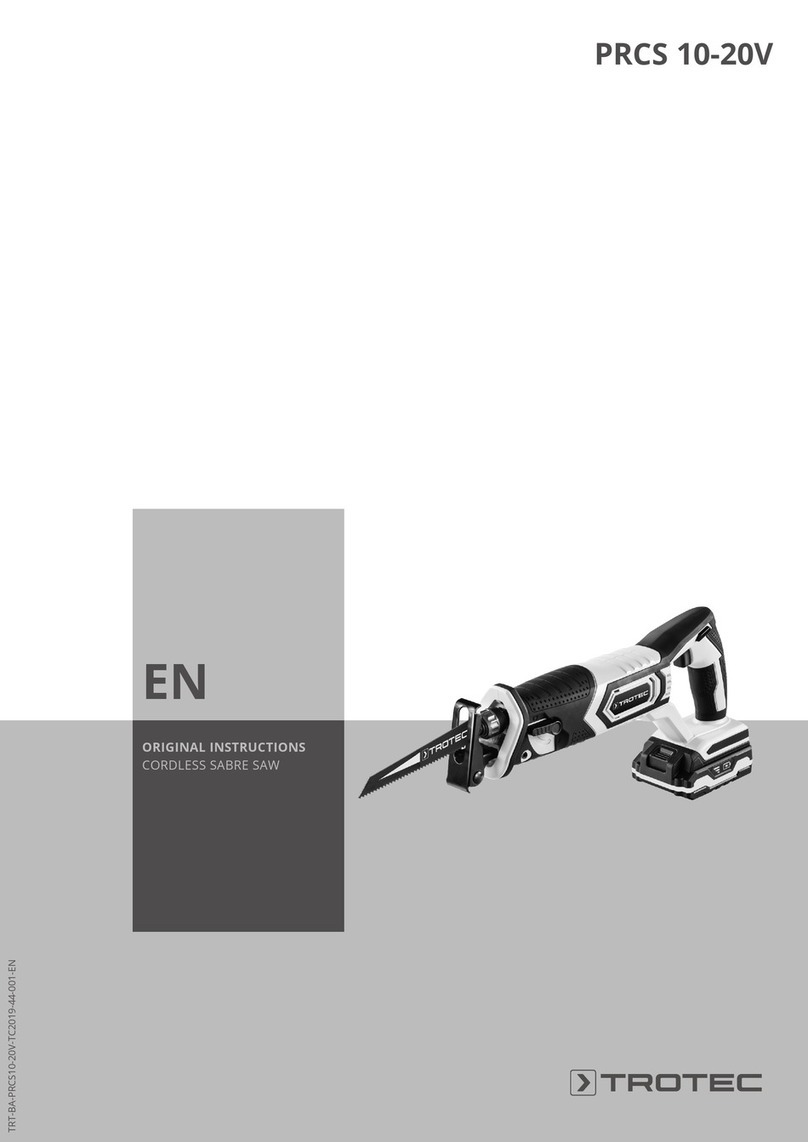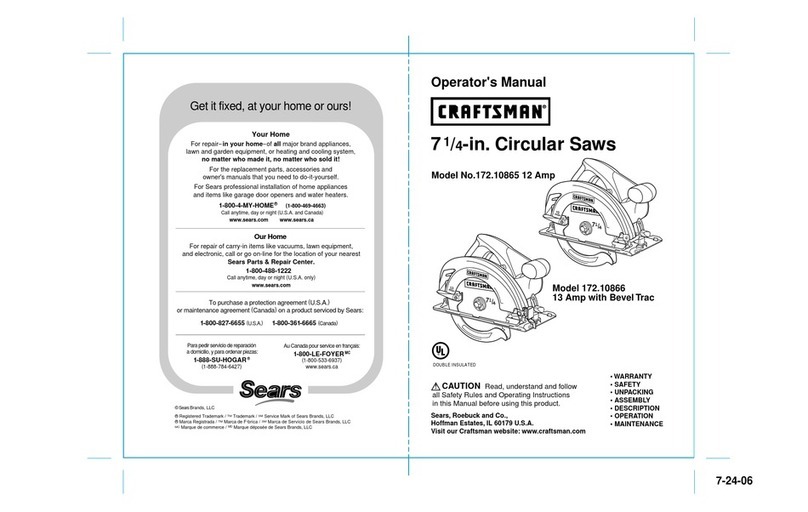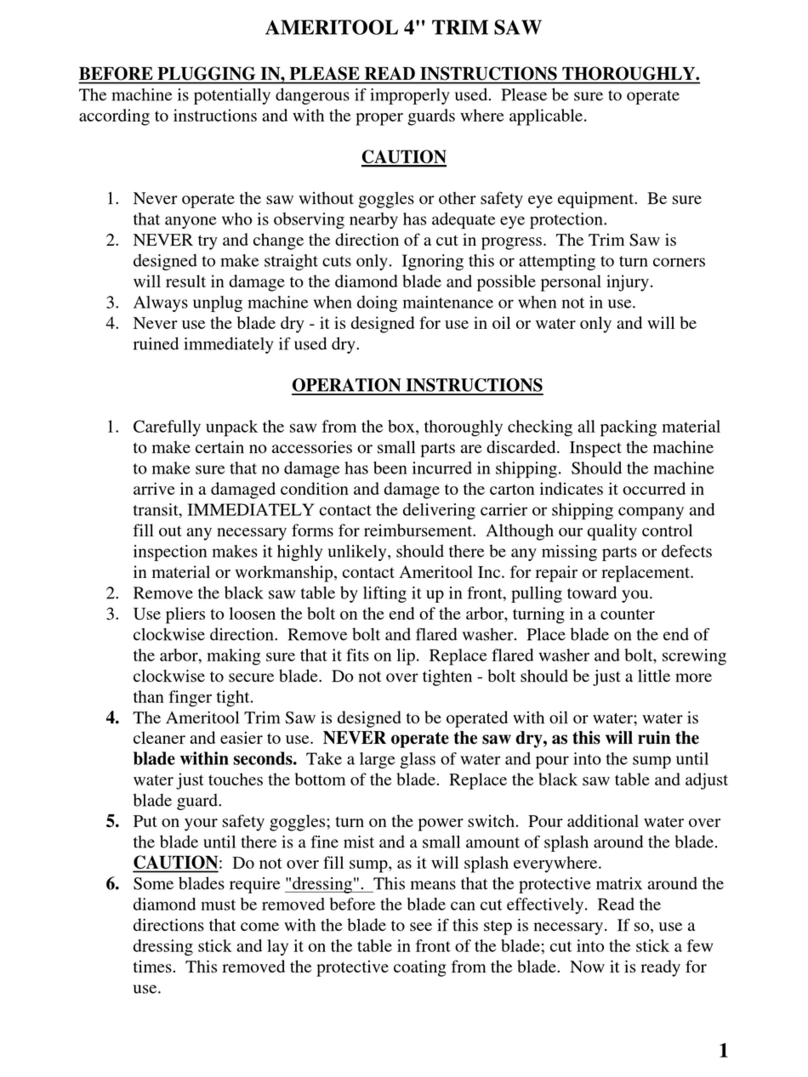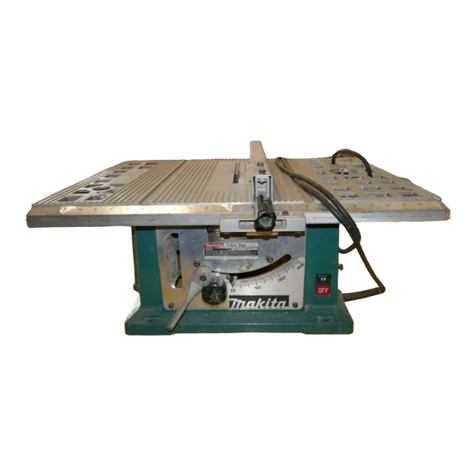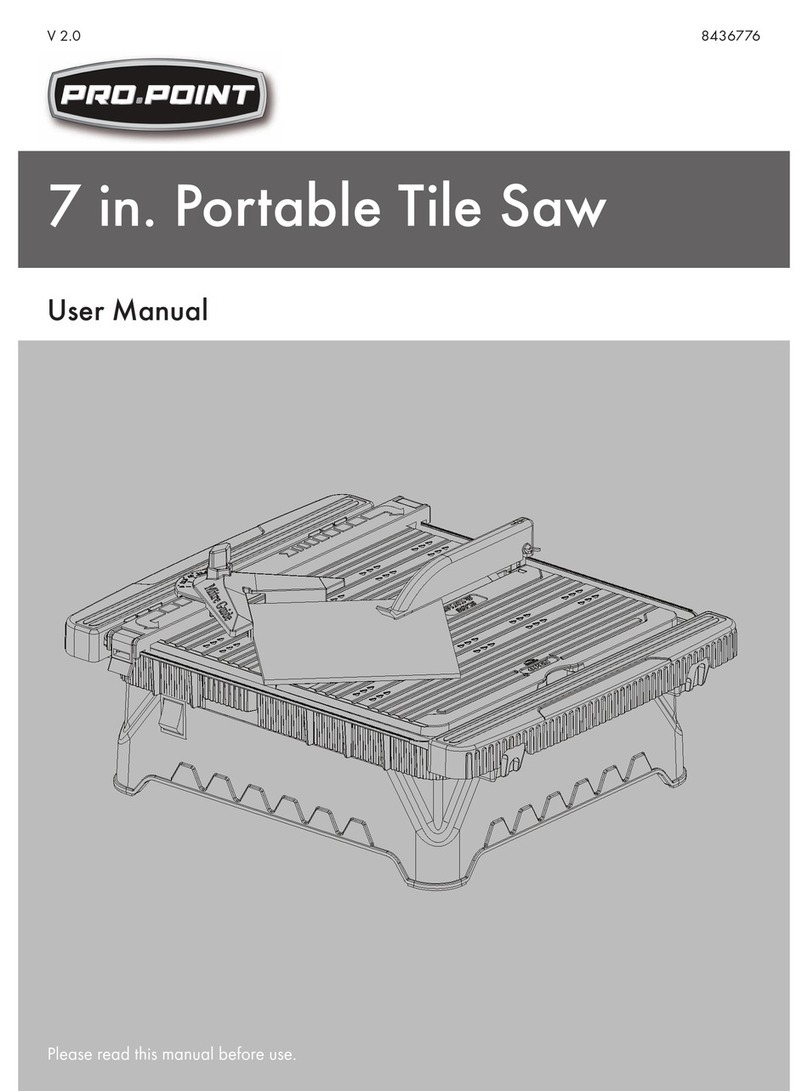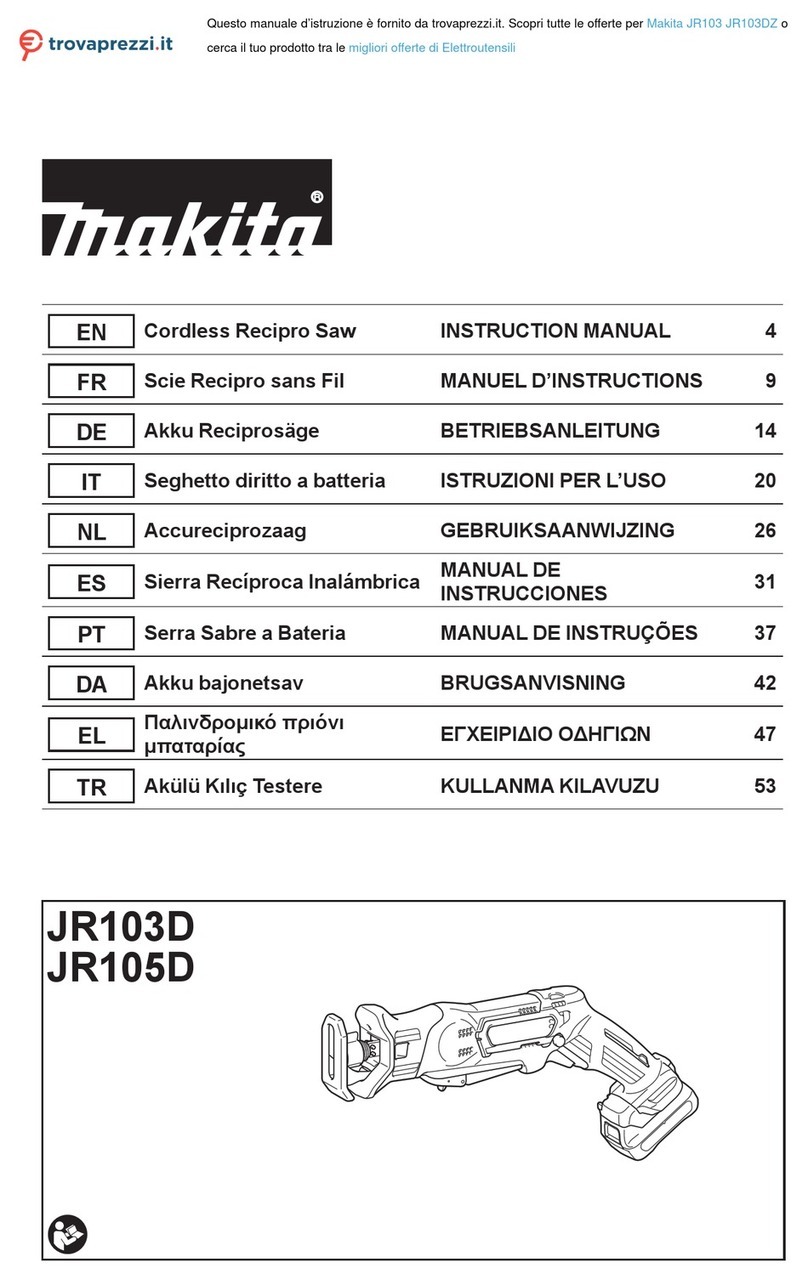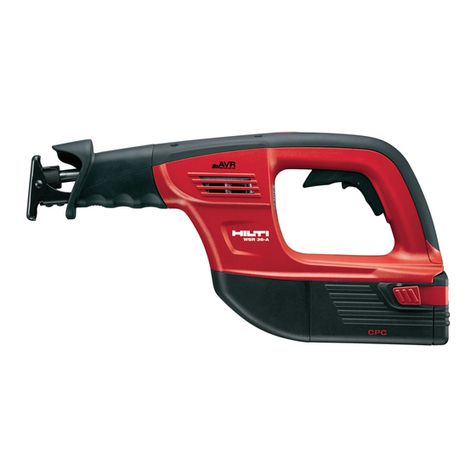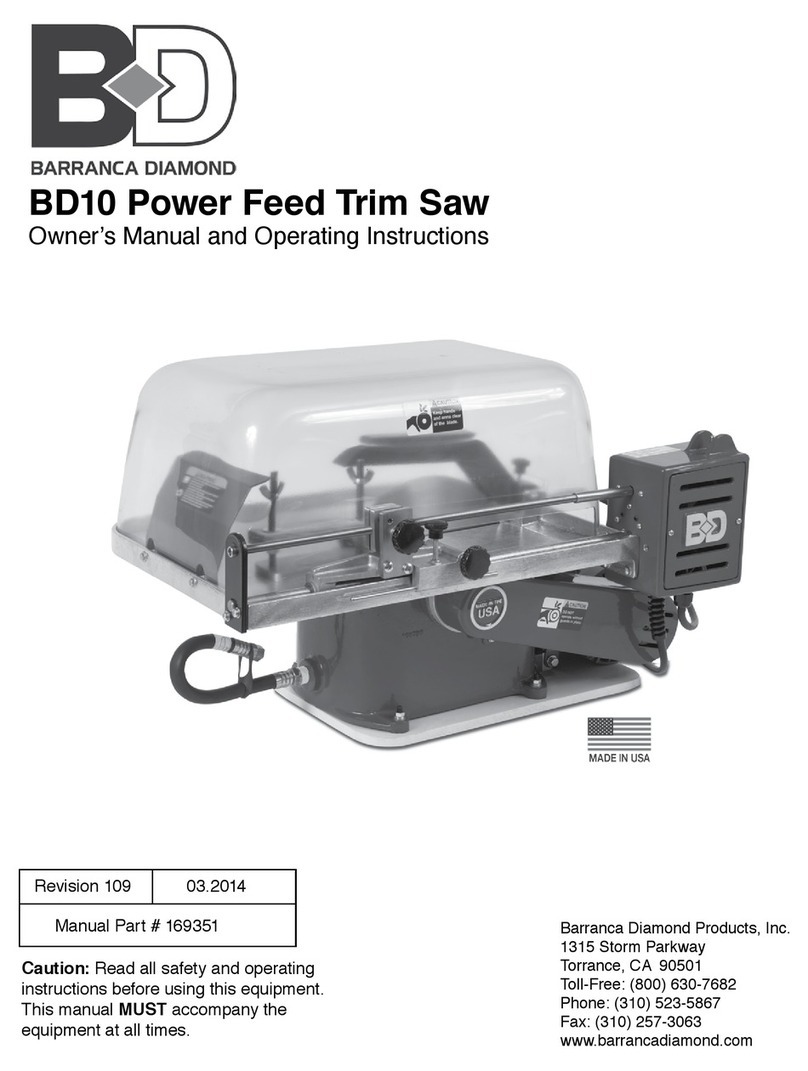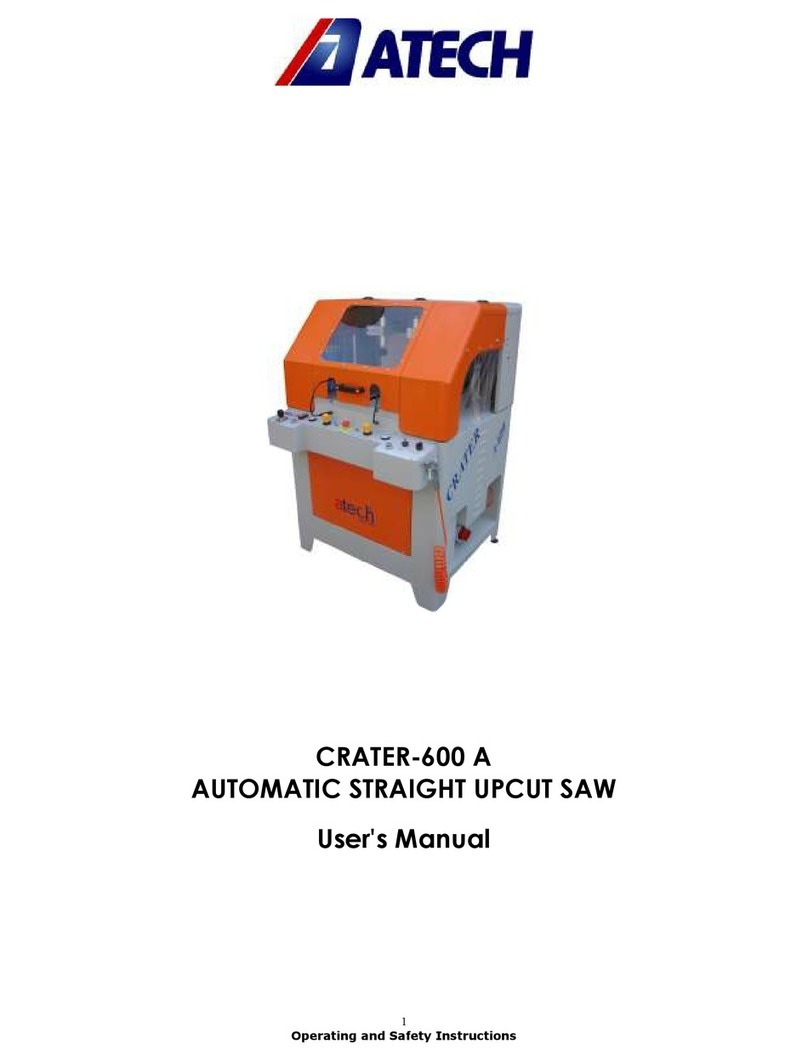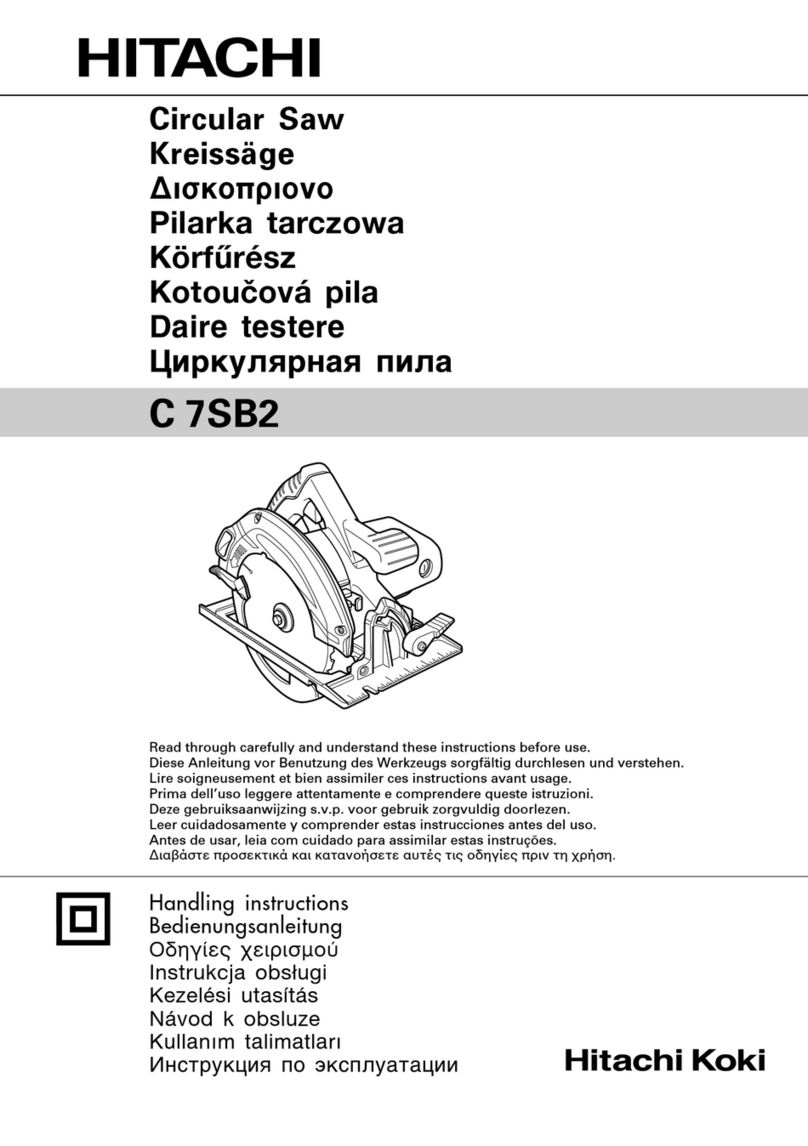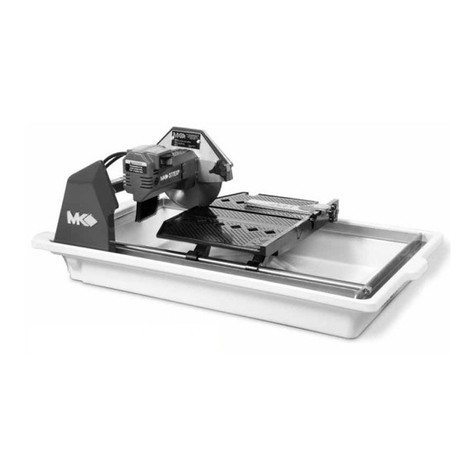TCK SJE10 User manual

ORIGINAL INSTRUCTIONS
CORDLESS GARDEN SAW
SJE10
INSTRUCTIONS MANUAL
READ THIS INSTRUCTIONS MANUAL BEFORE USE OF THE TOOL
TCK GARDEN
32 rue, Aristide Bergès – ZI 31270 Cugnaux - France
Tel: +33 (0)5.34.502.502 Fax : +33 (0)5.34.502.503

1. SAFETY WARNINGS
WARNING Read all safety warnings and all instructions. Failure to follow the
warnings and instructions may result in electric shock, fire and/or serious injury.
Save all warnings and instructions for future reference. The term "power tool" in the
warnings refers to your mains-operated (corded) power tool or battery-operated (cordless)
power tool.
1) Work area safety
a) Keep work area clean and well lit. Cluttered or dark areas invite accidents.
b) Do not operate power tools in explosive atmospheres, such as in the presence of
flammable liquids, gases or dust. Power tools create sparks which may ignite the dust or
fumes.
c) Keep children and bystanders away while operating a power tool. Distractions can
cause you to lose control.
2) Electrical safety
a) Power tool plugs must match the outlet. Never modify the plug in any way. Do not
use any adapter plugs with earthed (grounded) power tools. Unmodified plugs and
matching outlets will reduce risk of electric shock.
b) Avoid body contact with earthed or grounded surfaces, such as pipes, radiators,
ranges and refrigerators. There is an increased risk of electric shock if your body is earthed
or grounded.
c) Do not expose power tools to rain or wet conditions. Water entering a power tool will
increase the risk of electric shock.
d) Do not abuse the cord. Never use the cord for carrying, pulling or unplugging the
power tool. Keep cord away from heat, oil, sharp edges or moving parts. Damaged or
entangled cords increase the risk of electric shock.
e) When operating a power tool outdoors, use an extension cord suitable for outdoor
use. Use of a cord suitable for outdoor use reduces the risk of electric shock.
f) If operating a power tool in a damp location is unavoidable, use a residual current
device (RCD) protected supply. Use of an RCD reduces the risk of electric shock.
NOTE the term “residual current device (RCD)” may be replaced by the term “ground fault circuit
interrupter (GFCI)” or “earth leakage circuit breaker (ELCB)”.
3) Personal safety
a) Stay alert, watch what you are doing and use common sense when operating a
power tool. Do not use a power tool while you are tired or under the influence of drugs,
alcohol or medication. A moment of inattention while operating power tools may result in
serious personal injury.
b) Use personal protective equipment. Always wear eye protection. Protective equipment
such as dust mask, non-skid safety shoes, hard hat, or hearing protection used for
appropriate conditions will reduce personal injuries.
c) Prevent unintentional starting. Ensure the switch is in the off-position connecting to
power source and/or battery pack, picking up or carrying the tool. Carrying power tools
with your finger on the switch or energizing power tools that have the switch on invites
accidents.
d) Remove any adjusting key or wrench before turning the power tool on. A wrench or a
key left attached to a rotating part of the power tool may result in personal injury.
e) Do not overreach. Keep proper footing and balance at all times. This enables better
control of the power tool in unexpected situations.
f) Dress properly. Do not wear loose clothing or jewellery. Keep your hair, clothing and
gloves away from moving parts. Loose clothes, jewellery or long hair can be caught in
moving parts.
g) If devices are provided for the connection of dust extraction and collection facilities,
ensure these are connected and properly used. Use of dust collection can reduce dust-
related hazards.
4) Power tool use and care
a) Do not force the power tool. Use the correct power tool for your application. The
correct power tool will do the job better and safer at the rate for which it was designed.
b) Do not use the power tool if the switch does not turn it on and off. Any power tool that
cannot be controlled with the switch is dangerous and must be repaired.

c) Disconnect the plug from the power source and/or the battery pack from the power
tool before making any adjustments, changing accessories, or storing power tools.
Such preventive safety measures reduce the risk of starting the power tool accidentally.
d) Store idle power tools out of the reach of children and do not allow persons
unfamiliar with the power tool or these instructions to operate the power tool. Power
tools are dangerous in the hands of untrained users.
e) Maintain power tools. Check for misalignment or binding of moving parts, breakage
of parts and any other condition that may affect the power tool’s operation. If damaged,
have the power tool repaired before use. Many accidents are caused by poorly maintained
power tools.
f) Keep cutting tools sharp and clean. Properly maintained cutting tools with sharp cutting
edges are less likely to bind and are easier to control.
g) Use the power tool, accessories and tool bits etc. in accordance with these
instructions, taking into account the working conditions and the work to be performed.
Use of the power tool for operations different from those intended could result in a hazardous
situation.
5) Battery tool use and care
a) Recharge only with the charger specified by the manufacturer. A charger that is
suitable for one type of battery pack may create a risk of fire when used with another battery
pack.
b) Use power tools only with specifically designated battery packs. Use of any other
battery packs may create a risk of injury and fire.
c) When battery pack is not in use, keep it away from other metal objects, like paper
lips, coins, keys, nails, screws or other small metal objects, that can make a
connection from one terminal to another. Shorting the battery terminals together may
cause burns or a fire.
d) Under abusive conditions, liquid may be ejected from the battery; avoid contact. If
contact accidentally occurs, flush with water. If liquid contacts eyes, additionally seek
medical help. Liquid ejected from the battery may cause irritation or burns.
6) Service
a) Have your power tool serviced by a qualified repair person using only identical replacement
parts. This will ensure that the safety of the power tool is maintained
.
Hold power tool by insulated gripping surfaces, when performing an operation where
the cutting accessory may contact hidden wiring. Cutting accessory contacting a "live"
wire may make exposed metal parts of the power tool "live" and could give the operator an
electric shock.
This appliance is not intended for use by persons (including children) with reduced
physical, sensory or mental capabilities, or lack of experience and knowledge, unless
they have been given supervision or instruction concerning use of the appliance by a
person responsible for their safety. Young children should be supervised to ensure that
they do not play with the appliance.
Keep all parts of the body away from the saw blade when the saw is operating.
Before you start the garden saw, make sure the saw blade is not contacting anything. A
moment of inattention while operating saws may cause entanglement of your clothing or
body with the saw blade.
Wear safety glasses and hearing protection. Further protective equipment for head,
hands, legs and feet is recommended. Adequate protective clothing will reduce injuries
and accident from the saw blade.
Do not operate the garden saw in a tree. Operation of a garden saw in a tree may result
in personal injury.
Always keep proper footing and operate the garden saw only when standing on a secure
and level surface. Slippery or unstable surfaces such as ladders may cause a loss of
balance or control of the saw.
When cutting a limb that is under tension be alert for spring back. When the tension in the
wood fibres is released, the spring loaded limb may strike the operator and/or throw the
garden saw out of control.

Use extreme caution when cutting brush and saplings. The slender material may catch
the saw blade and be whipped toward you or pull you off balance.
Keep handles dry, clean, and free from oil and grease. Greasy, oily handles are slippery
causing loss of control.
Kickback may occur when the nose or tip of the blade touches an object, or when the wood
closes in and pinches the saw blade in the cut. Tip contact in some cases may cause a
sudden reverse reaction, kicking the blade up and back towards the operator. Pinching the
saw blade along the top of the guide bar may push the saw rapidly back towards the operator.
Either of these reactions may cause you to lose control of the saw which could result in
serious personal injury. Do not rely exclusively upon the safety devices built into your saw. As
a pruner saw user, you should take several steps to keep your cutting jobs free from accident
or injury.
Kickback is the result of tool misuse and/or incorrect operating procedures or conditions and
can be avoided by taking proper precautions as given below:
-Maintain a firm grip, with thumbs and fingers encircling the garden saw handles, with both
hands on the saw and position your body and arm to allow you to resist kickback forces.
Kickback forces can be controlled by the operator, if proper precautions are taken. Do not
let go of the garden saw.
-Do not overreach and do not cut above shoulder height. This helps prevent unintended tip
contact and enables better control of the garden saw in unexpected situations.
-Only use replacement blades specified by the manufacturer. Incorrect blades may cause
blade breakage and/or kickback.
Symbols
Warning symbol
Refer to the instruction handbook/booklet
Wear eyes protection
Wear hearing protection
Wear respiratory protection.

Residual risk
Even if you are operating this product in accordance with all the safety requirements,
potential risks of injury and damage remain. The following dangers can arise in
connection with the structure and design of this product:
1. Health defects resulting from vibration emission if the product is being used over long
periods of time or not adequately managed and properly maintained.
2. Injuries and damage to property due to broken application tools or the sudden impact of
hidden objects during use.
3. Danger of injury and property damage caused by flying objects.
WARNING! Some dust created by power sanding, sawing, grinding, drilling and other
construction activities contains chemicals known to cause cancer, birth defects or other
reproductive harm. Some examples of these chemicals are:
-Lead from lead-based paint
-Crystalline silica from bricks and cement and other masonry products
-Arsenic and chromium from chemically treated timber
Your risk from these exposures varies, depending upon how often you do this type of work.
To reduce your exposure to these chemicals:
-Work in a well-ventilated area.
-Work with approved protective equipment, such as those dust masks that are specially
designed to filter microscopic particles.
Intended use
This product is intended for straight cuts in wood and similar material with the installed blade.
The product must not be used for cutting logs.
The product must be used in an upright position only with the base plate lying flat on the
workpiece. It may not be used upside down or as stationary product on a work bench.
The supplied saw blade is only suitable for cutting wood and must not be used on other
materials.

2. YOUR PRODUCT
a. Description
1. Cutting Blade
2. Clamping Jaw
3. Shoe
4. Locking button for clamping jaw
5. Blade Holder
6. Safety Switch
7. Trigger
8. Battery pack
9. Battery Release Tab
10. Battery Charger

b. Technical data
Voltage
10.8 V d.c.
Speed
0-2500/min
Operating time (no load)
30 min
Stroke length
20 mm
Max cutting width
80 mm
Blade
152 mm
Sound power level
Lwa: 90dBb(A) K= 3dBb(A)
Sound pressure level
Lpa: 79dBb(A) K= 3dBb(A)
Vibration
Information:
The declared vibration total value has been measured in accordance with a
standard test method and may be used for comparing one tool with another;
The declared vibration total value may also be used in a preliminary assessment of
exposure.
Warning:
that the vibration emission during actual use of the power tool can differ from the
declared total value depending on the ways in which the tool is used; and
of the need to identify safety measures to protect the operator that are based on an
estimation of exposure in the actual conditions of use (taking account of all parts of
the operating cycle such as the times when the tool is switched off and when it is
running idle in addition to the trigger time).
Wear hearing protection.

3. ASSEMBLY
Warning! Ensure the battery is disconnected from the tool before performing any of the
following operations
The clamping jaw allows branches to be gripped, providing cutting of unsupported
branches easier. When cutting wider branches or timber, the clamping jaw can be
removed and the garden saw can be used as a standard reciprocating saw.
a. Fitting the Clamping Jaw
The clamping jaw cannot be fitted or removed with the blade fitted. If the blade is fitted,
first remove the blade and then follow the steps below.
Align the upper tab of the clamping jaw with
the hole in the saw housing.
Press and hold the locking button for
clamping jaw release into the unlock position.
Push the clamping jaw tab into the hole in the
housing and release the locking button for
clamping jaw.
Note: Ensure the clamp is secured by pulling the clamp away from the body.

b. Removing the clamping saw
Press and hold the locking button
for clamping jaw into the unlock
position.
Pull the clamping jaw away from the
saw body.
c. Cutting blades
Caution! Do not handle blades without gloves as they are sharp and can become
hot after use, potentially causing personal injury
Fitting a cutting blade
The garden saw can be fitted with standard reciprocating saw blades, therefore can be
used to cut various timbers and plastics. If the clamping jaw is going to be used, ensure it
is fitted before installing the blade.
Rotate and hold the ring of the blade
holder anticlockwise.
Insert the cutting blade into the slot of the
blade holder

Release the ring on the blade
holder and ensure the blade is
secure by pulling on the blade
d. Removing the cutting blade
Rotate and hold the ring on the
blade holder anticlockwise.
Remove the cutting blade from
the blade holder.
e. Charging the battery
Warning! The power supply for this charger should be protected by a residual
current device (rated at 30ma or less). A residual current device reduces the risk of
electric shock.
Place the battery into the seating
of the charger.

Plug the charger into a power
socket and the red charging light
should illuminate.
Once the battery is fully
charged the green light will
illuminate.
Note: It will take 4-5 charging cycles before the battery reaches optimum charge and
run time.
f. Installing and removing the battery
Push the battery into the battery
seating at the rear of the garden
saw until it clicks into place.
To remove, push the battery
release tabs on both sides of the
battery and then remove from the tool.

4. USE
a. Switching the saw on and off
Push the safety switch in from either side of the tool and then squeeze the trigger to
start the garden saw.
Release the trigger to stop the garden saw.
b. Cutting branches using the clamping jaw
Ensure the blade and the clamping jaw is secured correctly and holds the saw firmly.

Place the branch in between the clamping jaws and then lower to perform the cut.
c. Cutting without the clamping jaw
When cutting thicker branches or sawing wood or plastic the clamping jaws can be
removed to prevent them getting in the way of the cut. See page 7 to see how to remove
the clamping saw.
Position the shoe of the saw onto the material to be cut for stability and then perform
the cut holding the saw firmly.

5. MAINTENANCE AND STORAGE
When not in use, the tool should be stored in a dry, frost free location, keep out of
children’s reach.
Keep ventilation slots of the saw clean at all times and prevent anything from entering.
If the housing of the saw requires cleaning, do not use solvents. Use of a cloth only is
recommended.
Blow out the ventilation slots with compressed air periodically.
The blade can be sprayed with light oil to avoid rusting.
Note: we will not be responsible for any damage or injuries caused by repair of the
garden saw by an unauthorised person or by mishandling.
6. DISPOSAL
Electrical products should not be discarded with household products. According to the
European Directive 2012/19/EU on waste electrical and electronic equipment and its
implementation into national law, electrical products used must be collected separately and
disposed of at collection points provided for this purpose. Talk with your local authorities or
dealer for advice on recycling.

7. EC DECLARATION
TCK GARDEN
32, rue Aristide Bergès – 31270 Cugnaux - France
Tel: +33 (0)5.34.502.502 Fax: +33 (0)5.34.502.503
Declare that the following machine:
CORLDESS GARDEN SAW
Model: SJE10
Serial Number:
Is in conformity with the requirement of the Directive Machine 2006/42/EC
And also in conformity with the following Directive:
Directive EMC 2014/30/EU
Directive ROHS 2011/65/EU
And also in conformity with the following standards
EN60745-1:2009+A11:2010
EN60745-2-11:2010
EN55014-1:2006+A1:2009+A2:2011
EN55014-2:2015
Responsible of the technical file: Mr Olivier Patriarca
Cugnaux, 09/10/2018
Philippe MARIE / PDG
Table of contents
